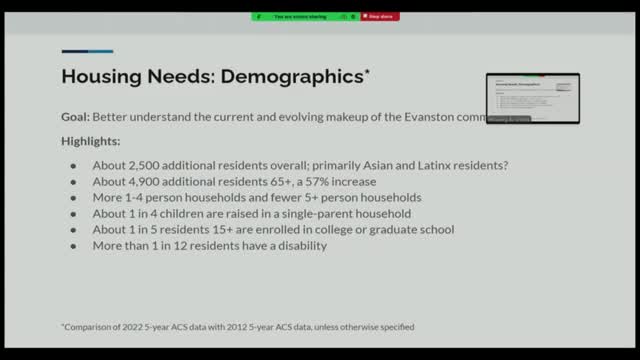Evanston faces housing crisis as rents soar
September 17, 2024 | Evanston, Cook County, Illinois
This article was created by AI summarizing key points discussed. AI makes mistakes, so for full details and context, please refer to the video of the full meeting. Please report any errors so we can fix them. Report an error »

Evanston has experienced a notable demographic shift over the past decade, with an increase in smaller households contributing to a diverse community landscape. Recent discussions during a government meeting highlighted that the city’s housing stock is nearly evenly split between renters and owners, with approximately 50% of homes built before 1940. This aging housing stock presents both challenges and opportunities for future urban planning.
The meeting also addressed pressing issues of housing affordability, revealing significant changes in rental costs. Many residents who previously paid less than $1,000 in rent are now facing higher prices, with a marked increase in those paying over $1,500. The data indicates that a substantial number of households are cost-burdened, spending 30% or more of their income on housing, with some severely burdened by spending 50% or more.
In terms of homeownership, the discussion differentiated between households with and without mortgages. Approximately one-third of mortgage-free homeowners spend $1,500 or more on housing, while nearly 90% of those with mortgages fall into the same category. This disparity underscores the financial pressures faced by newer homeowners who must navigate a market with rising costs.
As the community continues to evolve, the meeting concluded with a reminder of six priority questions aimed at guiding future discussions on housing and affordability, emphasizing the need for strategic planning to address these critical issues.
The meeting also addressed pressing issues of housing affordability, revealing significant changes in rental costs. Many residents who previously paid less than $1,000 in rent are now facing higher prices, with a marked increase in those paying over $1,500. The data indicates that a substantial number of households are cost-burdened, spending 30% or more of their income on housing, with some severely burdened by spending 50% or more.
In terms of homeownership, the discussion differentiated between households with and without mortgages. Approximately one-third of mortgage-free homeowners spend $1,500 or more on housing, while nearly 90% of those with mortgages fall into the same category. This disparity underscores the financial pressures faced by newer homeowners who must navigate a market with rising costs.
As the community continues to evolve, the meeting concluded with a reminder of six priority questions aimed at guiding future discussions on housing and affordability, emphasizing the need for strategic planning to address these critical issues.
View full meeting
This article is based on a recent meeting—watch the full video and explore the complete transcript for deeper insights into the discussion.
View full meeting
